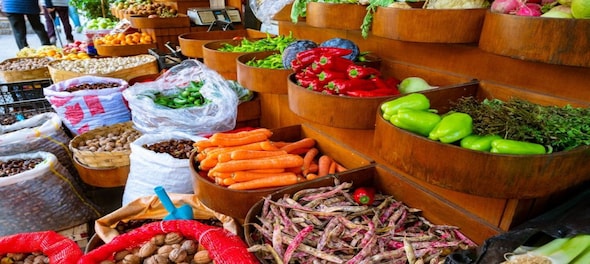
In a week, Goldilocks appears to have taken a somersault. She is standing on her head, with respect to Indian economic data. June Index for Industrial Production (IIP) has come in at an 11 month low of 3.7 percent, while the consumer price index (CPI) for July has come in at a 15-month high of 7.44 percent.
The July CPI is particularly concerning, because while it was expected to be high, thanks to tomatoes and vegetables, the actual number is way above market estimates of 6.6-6.7 percent, because of a sharp rise in cereals and pulses. Prices for both have risen by around 13 percent year-on-year. The month-on-month increase in cereals at 1.2 percent and pulses at 2.4 percent, is worrying.
It is natural for people to shift to pulses and cereals when vegetables are expensive, but there is more than demand pull, at work here. The extremely heavy rains in the north-west rice growing regions, coupled with huge monsoon deficits in the rice growing eastern regions of East UP, Bihar and Bengal are feared to lead to a far lower rice crop this Kharif than expected earlier.
Pulses are seeing higher prices due to higher demand and lower sown area, again due to expected weather conditions.
While data is disturbing to the policy makers, politicians, and bond and stock traders, let's spare a thought for the economically disadvantaged. A food inflation number of 11.5 percent year-on-year, doesn't reveal their terrible plight: Since the start of 2023, milk has become a luxury. Then veggies turned pricier and now even pulses and cereals are becoming beyond reach. Sugar is also inching higher. Only edible oils remain in check.
That said, the saving grace is, tomato prices seem to plateauing and even falling in many cities. Onions and potatoes are expected to follow suit by September. The government has started open market sales of wheat. We have stocks to manage rice prices as well through open market sales. Hopefully milk will become cheaper by October as the new calving season starts. Food as a whole may become more affordable when the festive season arrives. Although the pain may linger in the form of pricier pulses.
What about data and policy?
One big saving grace is that core inflation has come in lower than expected at 4.9 percent for July. The continued economic downturn in China means global commodities, except crude oil, will remain in check. Nevertheless, the overall data mix for interest rates has turned adverse.
The RBI had upped its Q2 CPI forecast from 5.4 to 6.2 percent in the August 10 policy statement and the Q3 CPI from 5.4 percent to 5.7 percent. It's now possible it may have to raise the Q2 forecast even higher to 6.8 percent. The full year FY24 CPI will also rise to 5.5 or 5.6 percent from RBIs August forecast of 5.4 percent. It is now clear that the chances of a rate cut recede to next August.
Are there even chances of a rate hike?
It's not just the food inflation, which RBI may explain away as transient. The global scenario has turned adverse. US 10-year bond yields have shot up to 4.2 percent from 3.7 percent in July and 3.5 percent in June. The dollar index has raced to 103.2, from sub-100 that it touched in July. All this because the US Producer price index has come in higher than expected and post the Fitch downgrade of US treasuries, bond experts like Bill Ackman have been speaking about the continued fiscal stress that can keep US bond yields higher for longer.
In an ambience of higher US yields and stronger dollar, RBI may have to worry about at least temporary flight of dollars and hence rupee weakness, though, it looks extremely unlikely it may have to resort to rate hikes to protect the rupee. The comfortable FX reserves and controlled current account deficit should help.
But, it is now very clear that RBI resorted to the Cash Reserve Ratio (CRR) hike on incremental deposits, not just to nullify the liquidity created by the return of the 2000 rupee notes, but because it genuinely fears excess liquidity will fan inflation. The central bank probably had an inkling that the July inflation will be far uglier than what the market was estimating.
Therefore, chances are that while RBI won't raise rates, it will keep liquidity tight. That means chances of the incremental CRR continuing beyond September 8, can't be ruled out. RBI governor said he has instruments other than rates, if inflation rises.
All told yields and rates look set to rise. Interest rate sensitive sectors like banks, NBFCs and real estate have some worrying periods ahead.
Finally, it's election season ahead. With high prices, one must expect government to tilt away from capex to full-on revenue expenditure through subsidies and income transfers. We are getting into a period of worsening fiscal, rising yields and slowing growth.
The time for trumpeting about our goldilocks economy and our impeccable macros has passed, at least for now.
(Edited by : Keshav Singh Chundawat)
Check out our in-depth Market Coverage, Business News & get real-time Stock Market Updates on CNBC-TV18. Also, Watch our channels CNBC-TV18, CNBC Awaaz and CNBC Bajar Live on-the-go!


Kannauj Lok Sabha elections: Can ex-UP CM Akhilesh Yadav reclaim this erstwhile SP bastion?
May 12, 2024 11:32 PM
Khunti Lok Sabha Elections 2024: Arjun Munda and Kali Charan to lock horns in this clash of tribal leaders
May 12, 2024 8:59 PM
Malkajgiri Lok Sabha election: A three-way contest among turncoats
May 12, 2024 8:45 PM

